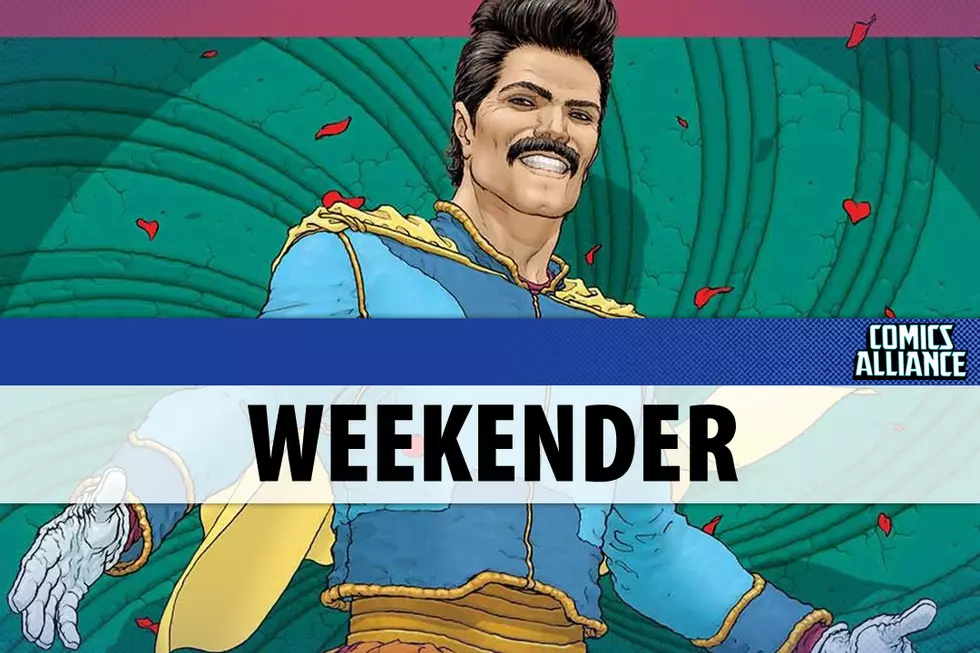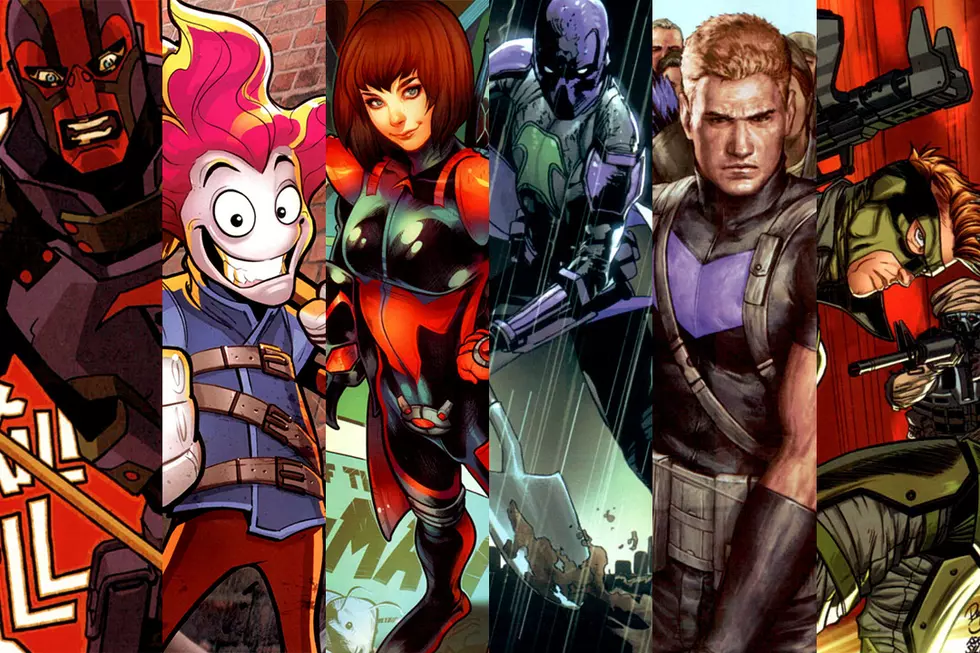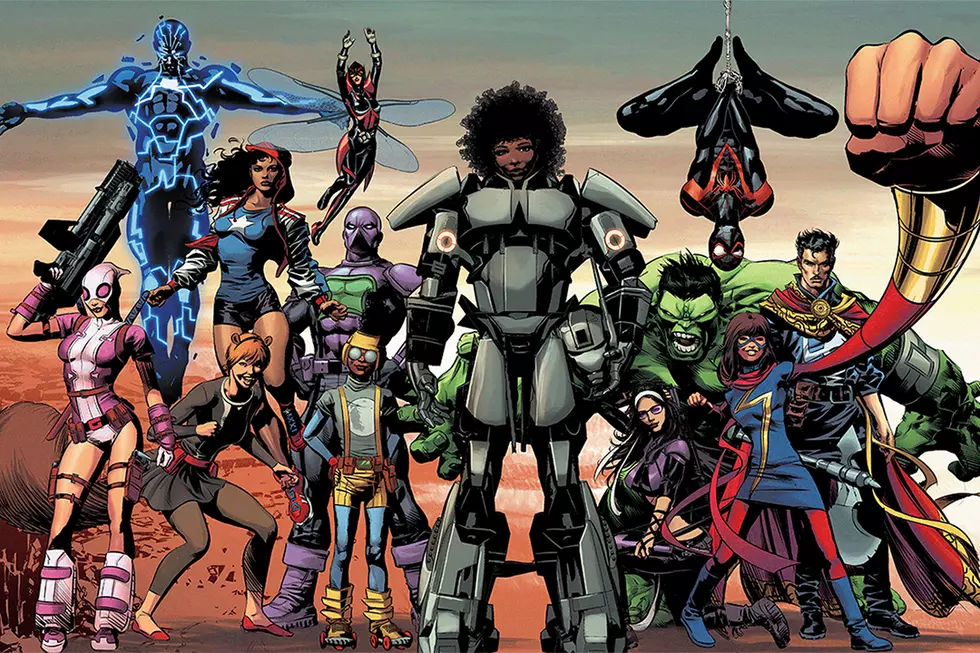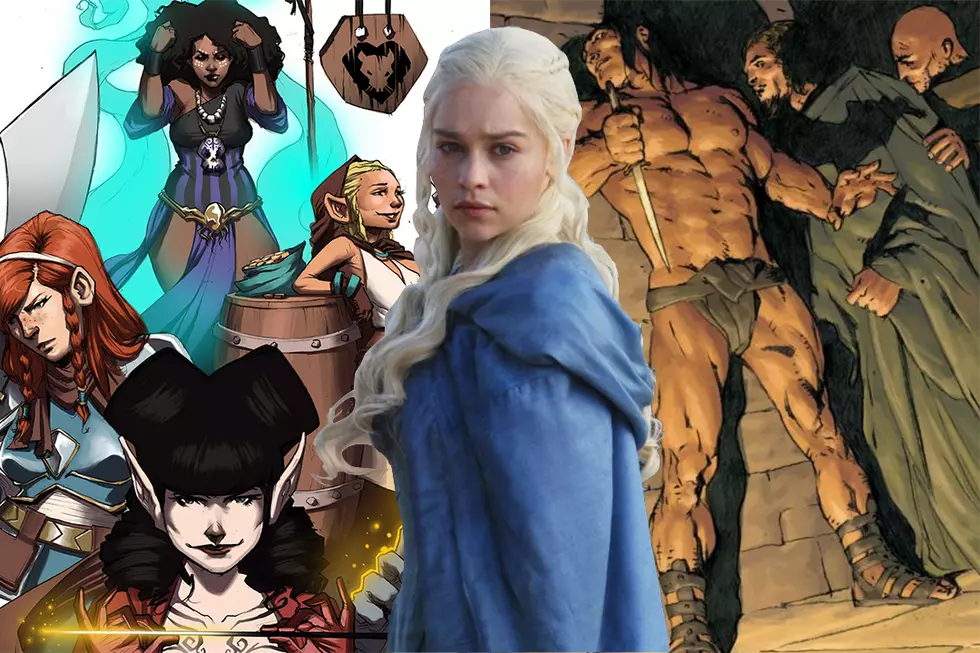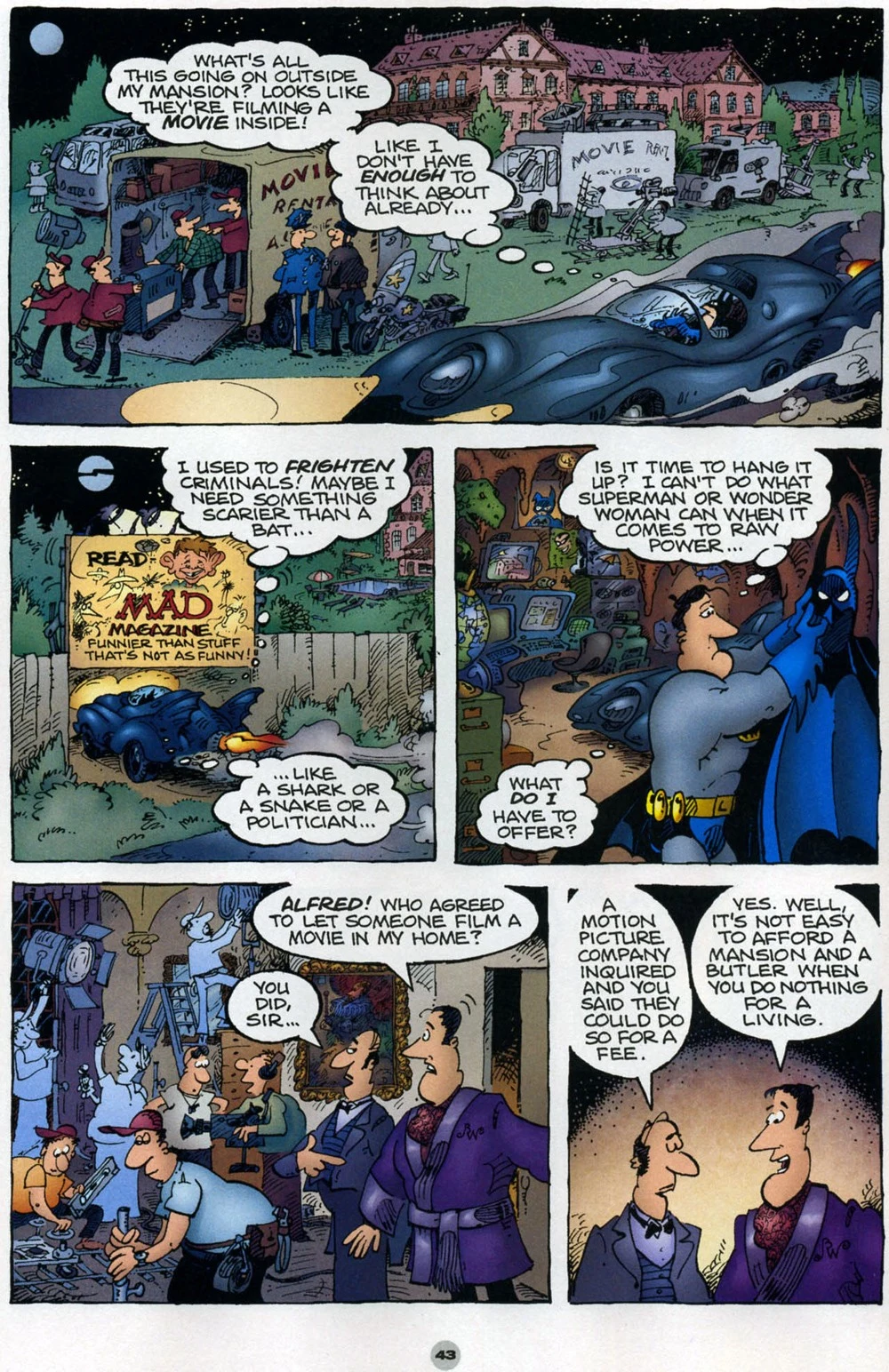
Duet On ‘Solo’, Part Eleven: Sergio Aragones

Published between 2004 and 2006, Solo was a DC Comics anthology series with an innovative twist: each issue was created from the ground up by a single cartoonist and collaborators of his own choosing. Edited by DC's head art director Mark Chiarello (Wednesday Comics, DC: The New Frontier), the series offered artists a platform to control their visions completely in the form of original stories, unfettered access to DC's library of characters, and without regard to continuity or other publishing concerns that affect the creation of a typical DC superhero book. Although Solo spotlighted the work of such talented and popular creators as Darwyn Cooke, Tim Sale, Paul Pope and Michael Allred, the series was cancelled after just 12 issues.
Even in a time when the superhero comics were experimenting wildly with structure and style, Solo stood apart and remains one of the best and most interesting mainstream series to emerge from the early years of this century. In this installment of Duet on Solo, writers Sean Witzke and Matt Seneca take an extremely close look at the eleventh issue of Solo, created by Sergio Aragonés.

Sean Witzke: Starting off, we've got to point out that on the cover of Sergio Aragonés' issue of Solo, he's deflating the logo itself, so we know what we're in for before even opening it.
Matt Seneca: Also, that the book isn't long for this world, as its cancellation was made public by this point during its release. (Man, how cool would it have been if in the final issue, Brendan McCarthy had shown that "S" as completely deflated and illegible?) There are earlier issues of Solo that seem to flirt perilously with being the kind of thing mainline DC doesn't typically publish, but I suspect the cancellation order must have come down somewhere between Scott and Aragonés, because pretty much all the accession to "house style" gets removed here, replaced by "whatever the guy happens to be good at."
SW: There is a Batman story called "A BATMAN STORY," but that is about it. Aragonés isn't a guy you hire to do anything but what he does, and DC and Marvel had both hired him to do exactly that before, in Aragonés Destroys DC and Massacres Marvel. But that was in the more funny one-shot friendly '90s. Here in Solo, aside from the Batman story, he doesn't even make fun of superhero comics in spite of his reputation for doing just that in superhero books, like a kind of zanier, more MAD-school Fred Hembeck. Aragonés is pretty much taking all his space to do oral histories about whatever he feels like, interspersed with serious and funny shorts. Aragonés actually comes on screen in the first story, "I Killed Marty Feldman," and explains his process as taking his experiences -- whether from research or his real life -- and putting them into what he's working on for this issue. It helps that he's a master of the form and his life story is actually incredibly interesting.
MS: I really hope we do get the Complete Sergio Aragonés Autobiography graphic novel at some point, or at least a collection of all his autobio shorts assembled into some kind of chronological order. Solo #11 is really Sergio Aragonés Funnies #0, isn't it, with Aragonés given carte blanche to basically express himself however he wants over the course of a full-length pamphlet comic? Pretty much everything the guy does that isn't Groo the Wanderer gets a decent airing in the issue: short stories, silent gags, superhero send-ups, rambling anecdotes that never fail to amuse.
SW: There are a bunch of Groo in-jokes too, which is nice.
MS: Yeah, he actually gets a tiny cameo in the same panel as Spider-Man! Is that legal?
SW: There's Mickey Mouse and Astro Boy and Asterix dolls in his office, too, which is just fantastic because you get the impression that at this point DC was policing Solo less. I think if Mike Allred had wanted to do the Batusi cover after cancellation they wouldn't have batted an eye.
SW: So let's start with the intro before the actual stories. It is a pretty smart and sly "I LOVE BEING A FREELANCER" joke where Aragonés explains his life is amazing before Chiarello calls him and he's ground down into a sunless life of being chained to a drawing table. It's pretty nice to see that even in a "do what you want" scenario like Solo there's still the option to bitch about it. And then he goes into legitimate autobio with the first story.
MS: That intro isn't actually too different from the fourth wall-breaking openings a few other artists start their issues off with, but Aragonés' is by far the most successful. Partly because there's a punchline to it, partly because his dashed-off drawing style suits the laid-back conspiratorial tone the piece strikes, and partly because he isn't trying to be cute. I think it's important to make note of that, because the guy with by far the cartooniest style of any Solo contributor spends maybe the least amount of pages (aside from Kristiansen, anyway) going for those cheap "awwwww" moments. He's locked into telling stories with as much heft and payoff as he can give them in a few pages -- even the gags are clever. The closest the comic gets to sappy is the Batman story at the end, and that one's written by Mark Evanier, not Aragonés himself.
SW: Yeah that's the thing about being actually funny, you don't have to cheat by being cute. Also there's an element where he's going for what's funny, so throughout "I Killed Marty Feldman" and the story of him moving to New York, he's the butt of the joke in nearly every panel while the other characters are glaring at whatever dumb thing he did. You have to actually have the ability to take the shots at yourself to be consistently funny in autobio, let alone in to-camera monologues, and all the other Solo guys took themselves too seriously or just didn't try it if they were Mike Allred.
MS: Yeah, Aragonés' on-page persona is almost kind of like Alan Moore's interview persona meets Homer Simpson; constant self-deprecation that makes you just like the guy more and more, shot through with a ton of expertly orchestrated slapstick.
SW: So "I Killed Marty Feldman." I've got to tell you my favorite thing about this story, beyond how it's a perfect joke to get you on Aragonés' side forever, is that he doesn't just draw famous Marty Feldman -- he draws him in the costume from Sherlock Holmes' Smarter Brother.
MS: And shortly before he draws Feldman flushing a gigantic bag of heroin, joints, cocaine, and numerous pills down the john. They really were getting canceled soon! Yeah, there's so much charm in the way Aragonés sets these stories up. It's cliché to say this about comics' humorists, but I'm constantly impressed at how the stories Aragonés tells basically carry all their own humor, and then the drawings just add in anecdotal jokes. You can marvel over just about every drawing in here just because of how well observed everything is. And of course, the punchline to this story is pretty fantastic. Not a hoax, not a dream, not an imaginary story: it seems likely enough that Sergio Aragonés really did kill Marty Feldman!
SW: This story illustrates that Aragonés is this man who gets phone calls to star in his friends' movies because he's a great guy, but the entire story just undercuts that as often as it can.
MS: He's the guy we all know who can't ever have an adventure without it turning into a misadventure, but somehow always comes out the other end of everything without a scratch.
SW: The western short "The Edge" that follows is probably the weakest thing here but it delivers on it's inevitable punchline.
MS: Which, like a few others in this book, is a pretty dark punchline. I'm always struck by how closely this story's warps and wefts follow those of some of the EC-style snap-ending shorts played for their gritty aspects by some of Solo's earlier artists. Throw this script at Jordi Bernet or Howard Chaykin and I think you'd come away with something that would feel perfectly of a piece with their issues. To me, this is the one that best illustrates how much of an asset Aragonés' drawing is: he's funny because he makes funny pictures.

SW: The way he draws the kid protagonist of the story is what sells it, he just seems like a stupid, trigger-happy brat that deserves what happens to him, and his mother is entirely sympathetic. It's interesting to see how this story ranks up with the samurai story that appears later in the issue that plays a similar foregone conclusion completely straight and draws a ton of gravitas from the comparison.
MS: It's all in Aragonés' emphasis on or limiting of his trademark goofy faces, overdone reaction shots, the EC Segar in his style. In "The Son and the Sword," all the physical agony (which is considerable) is obscured or shown off-panel, because if Aragonés were to render it the way he draws, its impact would be all wrong. In this Western thing, though, it's just BOOM, dude getting knocked into midair by a gunshot -- HILARIOUS! There's a lot more subtlety to Aragonés than is really visible from just looking at his art, or even reading only one of his stories.
SW: With respect to the samurai story, I guess we've got to note that Aragonés has a long collaboration and friendship with Stan Sakai, creator of Usagi Yojimbo, and the character does make a cameo appearance in the title card of the "Heroes" strip. We should probably factor that into Aragonés doing a (relatively somber) samurai piece.
MS: Sakai is definitely all over this thing. We should also mention that he actually hand lettered this whole comic.
SW: Sakai's lettering is like the secret ingredient to Aragonés' comics. He and Sakai and Evanier have been a three-headed team since the early '80s.
MS: One of comics' great, unheralded collaborations, for sure. (Though a dude came into the comic shop I work at the other week talking about how Groo was The Greatest Comic In The Medium's History, so maybe I just hang out with the wrong people... or on second thought, maybe not.)
SW: It is, it's like Cerebus but without the speeches and funnier. Also without the "contact with women's vaginas melt good Christian men's souls" messages or whatever Sim was talking about.
MS: Anyway, this samurai story is actually a pretty great entry in one of American comics' less utilized genres. It's told with a surprisingly light touch, which is especially cool given how anvil-to-the-cranium Aragonés can be throughout the rest of the issue. But he plays it straight, here, and manages a character-driven piece of genre that earns its place among the funnier comics in the book. Though it's interesting how even this story, shorn of just about all comedic inflection, still utilizes the logic of the punchline at its ending.
SW: There's some truly great cartooning with the design of the Baron Tako, how he looks disheveled and ridiculous but is still told as honorable. It is this fantastic way of humanizing the character's mistake without turning him into a fool -- or at least not all the way. It's that subtle design work that you really don't expect from Aragonés that he delivers so well on in this series.
MS: That is a great design. It accomplishes basically the same thing Aragonés' depiction of himself does: making "not knowing what the hell you're doing" into a pretty sympathetic position.
SW: There are three gag strips. One is the traditional "private eye finds his own wife cheating," one of a snitch being thrown in the ocean by mobsters, and the other is a King Kong sex joke. I think the King Kong joke is the more successful of the three because I have yet to read/hear/see a King Kong joke that isn't funny. But the problem with all three is because they are just joke two-pagers, explaining them is kind of senseless and missing the appeal. The "silent" aspect just shows how great a control Aragonés has over his cartooning, I'd have to say. But mostly they're just perfectly timed.

MS: Yeah, it's mastery over the tropes being manipulated rather than the tropes themselves that makes these strips interesting. Aragonés the writer is basically a raconteur -- the more rambling and anecdotal his stories, the better -- but these strips are where his genius for cartooning really gets to shine, making even the most hackneyed jokes feel fresh and immediate because of the dedication he gives to them. I will say that the King Kong role-play strip is pretty friggin' outre for a DC comic, impending cancellation notwithstanding.
SW: You've got to note, that joke wouldn't even get an eye-bat from the MAD end of Warner Bros.' publishing operation, which is where Aragonés is used to working. These are all MAD jokes too, so the hack aspect to them is kind of a strength rather than a detriment.
MS: Totally. I dig avant-garde, non-sequitur humor as much as the next guy (especially in comics), but you've got to have the meat and potatoes, I guess. This stuff is timeless, and when it's well done there's really nothing to complain about.
SW: The "Heroes" story is great comics, probably my favorite piece in here that doesn't involve Marty Feldman. Even if the message seems to be a little of the hoary, "the truth seems to be somewhere in between," the specificity of the historical event is what elevates the material from being "I was taught one thing but my kids were taught another," and the details Aragonés uses are what keep it from resembling a This American Life segment. Details like the kids trading comic books, or the signage behind the army recruiter as he press-gangs the off-the-boat Irish immigrant.
MS: I was really struck by just how similar this comic is to the work of first wave underground comix artist Jack Jackson, who spent decade after unheralded decade making amazing comics about the history of the Southwestern United States, all of which basically made the same point Aragonés does here: the history we get in schools is claptrap, this country was built on more virtuous people's bones, and there is no such thing as an American hero. And when I say "how similar," I mean "exactly the same," aside from the particulars of visual style. That means everything, though. DC would never in a million years publish the kind of rabble-rousing, neo-John Severin-at-EC comics work Jackson did, but the broadness and affability of the way Aragonés draws allows him to work in veins that wouldn't be available to most other artists doing the gigs he sometimes does.
SW: This reminded me a little bit of Larry Gonick's Cartoon History of the Universe book as well, which tries to maintain a light touch as it lays out constant unending violence in the history of the world. But Aragonés is smart to frame the material as a personal experience, he wouldn't even be considered to be rabble-rousing with this piece. It also smartly creates the conversation for the rest of the issue that presenting a hero isn't necessarily the point of telling a good story, and Aragonés' concept of a hero is someone who actually has committed an act of "heroism." As such, when he takes on Batman it's pretty hard to take seriously, but by the same token the samurai story is very clearly positing the son as a hero in that sense.
MS: And Aragonés himself is really kind of a hero in the autobio stuff. It's not about engaging in derring-do so much as it is just being a good protagonist, being able to lead people from one place to another -- the cardinal virtue of both comedy and cartooning. I think Aragonés' story of arriving in New York City for the first time is my favorite thing in here, and a big part of it is how charmingly he's able to present himself as a lead character, despite the entire story basically being him just getting buffeted around by crazy 1960s NYC.
SW: The absolute best punchline in the whole comic, too. I really love that he kind of shouts out the "I Arrived In New York" horror stories as he goes but doesn't shirk that he's still the butt of the joke in nearly every panel: his family wondering why he couldn't be an architect, guys on the street wondering why he's dressed like it's winter.
MS: And those horror stories just aren't that bad the way Aragonés tells them, either. His sunny outlook is really welcome, just this constant affirmation of the choices he made, even when they led him into some pretty weird places. Almost Candide-esque.
SW: It's the story of a guy's life told from the perspective of "and that's how I got here," and it's just such a wonderful tone because you never see it in comics. Even Eddie Campbell's great semi-autobio comics, which you could compare to Aragonés in tone, seem to critique his decisions quite often. Instead, these are, "Oh you wouldn't believe this great thing," which is joyously told, even in the bad moments. It's rare.
MS: The closest this comic gets to a sentiment of critique is in the final, Mark Evanier-penned Batman story. I'm not really a fan of this thing, especially given how masterfully and dramatically Mike Allred hit the same notes a few issues earlier. It's nothing bad, and there's some great whirlwind cartooning, but it just doesn't seem to bring anything new to the conversation.
SW: In terms of tone, I think it's less solemn than the Allred story. I would want to hang out in the Aragonés Batcave before the other more famous depictions of it. Actually, that giant Jim Lee fold-out is basically the same picture only drawn without a sense of humor.
MS: There's a metaphor here, I can feel it! I guess my problem with the story Evanier writes, which does raise some valid points, is just that the solemnity and the longer treatment Allred gives the same idea makes it feel like it Actually Matters, whereas here it's just kind of another confection among many.
SW: The "how I have a mansion and a butler with no job" joke is fantastic. I dunno about the rest of the jokes. I really like his snooty Bruce Wayne, as well.
MS: Yeah, like Kristiansen before him, I think Aragonés the writer outshines his collaborators.
SW: This is one of the most solo issues of Solo, right? Kristiansen had two writers, McCarthy had a bunch on hand even though many of them may have just been him. There aren't any adaptations here either. It's unfiltered Aragonés, which is fantastic and even the collaborators are the two dudes he's worked with since before Chiarello was even editing comics.
MS: It's pretty unfiltered stuff, as is the next and final issue. I always kind of see this issue as a bold new direction for Solo that was unfortunately not taken as far as it deserved to be -- almost a total lack of restriction, which was where the book needed to end up, really. As it is, the Aragonés issue ends up looking like an odd man out, a humor comic among serious, superhero-heavy action material. If only there could have been a few more of them like this.
SW: Well, if year two of the book had ever happened, Kyle Baker probably would have followed Aragonés' lead, I think it's safe to say. But such is publishing anthologies.
MS: C'est la guerre! Oh well, the best -- at least if you ask me -- was still yet to come.
SW: Nah, this was the best, for me. McCarthy only came close.

More From ComicsAlliance
![The Best Dark Horse Comics Covers of 2016 [Gallery]](http://townsquare.media/site/622/files/2017/01/featured.png?w=980&q=75)
![Solo Is Not Necessarily The Best There Is At What He Does In New ‘Solo’ Series [Preview]](http://townsquare.media/site/622/files/2016/09/Solo_1_Featured.jpg?w=980&q=75)
